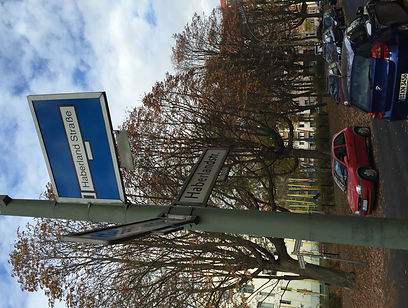
Places of Remembrance

BACKGROUND
Places of Remembrance is a memorial located in the Bavarian Quarter in the former Jewish District of West Berlin. The memorial has been created by Renata Stih and Friender Schnock to commemorate the Jewish community, with 16,000 residents in 1933, prior to the Shoah. The installation was introduced to the area in 1993, shortly after the reunification of Berlin and was one of the first efforts to permanently recognise the ways in which the Shoah infiltrated into daily life in Berlin. At this time the topic of Holocaust remembrance was more of a taboo and not such a potent part of Berlin’s contemporary landscape.
The installation is made up of 80 double sided placards attached to lamp posts, on one side is a condensed version of anti-Jewish laws which were implemented in an attempt to entirely dehumanise the Jewish population. On the reverse side of the sign is a simple, innocent graphic which directly corresponds to the disturbing and anti-Semitic regulation. The signs are integrated into the present day landscape of the residential Bayerische Platz neighbourhood in Berlin and thus have become embedded into the local life which is unsettling as it entices the public to engage with the history of that space on a personal level, on a daily basis.
 |
|---|
 |
 |
 |
 |
 |
 |
 |
 |
 |
P
I
C
T
U
R
E
S
L
I
D
E
S
H
O
W
WRITTEN IN THE FORM OF PERPETRATORS
The Nazi legislation on the sign posts have been rewritten in present tense and show the laws from the perpetrators and not the victims' perspective. At the bottom of the placard there is the date that the rule was passed, this gives a sense of timeframe in which the oppression worsened and clearly displays the ways in which the Nazis mobilised, shaped and destroyed the everyday day lives of Jewish residents.
There is a fundamental geographical element to this public art memorial as the signs are coordinated with their surroundings. For example, outside the Bayerischer Platz U-Bahn there is a signpost with a large ‘U’ and the legislation states that “Jews are not allowed to use the public transport”.
This serves to shock and enrage people passing by the station as the mundane activity of travel was forbidden to Jewish residents, a further illustration of the removal of freedom and of basic ‘rights’ which may be taken for granted in modern Berlin.
DE-CENTRALIZED MONUMENT
The memorial installation is a counter-monument which explicitly links the freedom of life in Berlin today with the regulations which deduced Jews, and other ‘non-Aryans’ to become systematically deprived of their jobs, rights and eventually their lives. The rules seem so barbaric, shocking and unjustified and are paradoxical to the liberal life in the contemporary area. The signs are subtly omnipresent throughout the area and are situated on almost every road throughout the Schoeneberg neighbourhood, disguised as regular street signs, not obviously but potently creating a mark on the landscape.
The signs are intended to induce opinions from people from different walks in life: historians, academics, artists and the local population for example, to make it accessible, personable and to provoke a debate in trying to understand the notion of everyday violence and the banality of evil. The first sign which was installed had a picture of a cat on one side, and the corresponding decree is “Jews are not allowed to have pets”. This reasoning behind this is to remove the animals from the Jewish households, so the owners could be displaced next. If the banishment of Jews is not disturbing to all people in the neighbourhood, then the thought of removing pets might be more vexing.
The intention of the street signs is for people to ask questions, ask why the images are placed around the city and for people to come up with answers and try to justify the harsh Nazi laws. The memorial is uncomfortable as it starkly displays the cruelness of the Nazis and raises many questions of how this was allowed to be executed.
The commemorative signposts incorporate the idea that political violence has infiltrated into everyday life through memorials, recreated on linguistic and pictorial level. The governing principle of the memorial is, in Stih's words, to "make visible the conditions which led in an insidiously logical way to the destruction of the Jewish inhabitants." The memorial is meant to illustrate that the destruction of the Jews in Germany was not a sudden, irreversible occurrence, but in contrast was a slow process consisting of a plethora of rules and laws, ranging from petty restrictions to the eradication of all rights and ultimately ended in the deportation and murder of thousands of Jews. The network of street signs reconnects the neighbourhood with its history.


